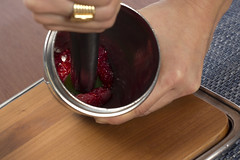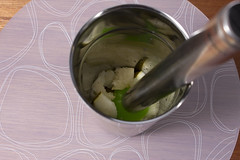
Muddling for Flavor:
One of the easiest ways to introduce a flavor into a cocktail is to muddle. This technique is great for seasonal ingredients like fresh herbs and fruit, and requires very little pre-preparation – meaning it can be a good choice if you don’t have the time to create a syrup or infusion.
How to:
- No pre-prep is needed, unless you choose to chop your fruit smaller before muddling.
- Muddle your ingredients with as little liquid in the glass as possible. This is cleaner and easier – avoiding “splashing”
- When muddling both fruit and herbs, muddle the fruit first. Add some sugar to provide abrasion and help extract the oils and muddle away.
- Add the herbs when you’re nearly done – as herbs need far less muddling to release flavor and can turn bitter if muddled too much.
- After muddling, then add the rest of your ingredients.
Benefits & Drawbacks of Muddling
[table]
Benefits |
Drawbacks |
| One of the greatest benefits of muddling as an approach is the fact that it requires very little pre-preparation. This means that a bar program can be relatively flexible and prepare muddled cocktails on-demand | Muddling is time-intensive and can’t be done in advance. This means that each drink must be made one-at-a time and this can be a challenge to keep up in a busy bar. |
| Muddling is a great way to get even more flavor and oils out of fruits that have rinds – especially citrus. The Caipirinha is a great example of the benefits of this technique. | Muddling can be messy. Even if the muddling process itself can be kept in the tin, the process of fine-straining will almost certainly create a sticky mess. |
| Finally, muddling is a great low-effort way to test flavor combinations. You can muddle a few flavors together in a cocktail to confirm they work well, and then choose to use a different flavor technique like syrups or infusions. | Since muddling is generally done using fresh ingredients, it comes with some of the other challenges that fresh ingredients bring. It can be difficult to predict and control sweetness, ripeness and flavor in fresh ingredients, so cocktails can be hard to replicate. |
| Guests love seeing bartenders make muddled cocktails. As a result, if you make one, you’ll often end up with several more of the same order immediately afterward | Guests love seeing bartenders make muddled cocktails – so if you end up with several orders in a row and the drink is time-consuming to make, you may end up over your head. |
[/table]

Muddling Tips & Take-Homes:
When choosing a method for introducing flavor into your cocktails, muddling can be a good choice when:
- You’re not concerned about a cloudy looking cocktail
- You’re looking for a drink that showcases the bartenders’ ability in front of the customer
- You really want to emphasize the use of extremely fresh ingredients
- You’re confident that the person preparing the drink will have the time to prepare (and taste & tweak) each individual cocktail
- When it’s really important that the most oils & juices are extracted from citrus – like, for example, in the Caiparinha.

